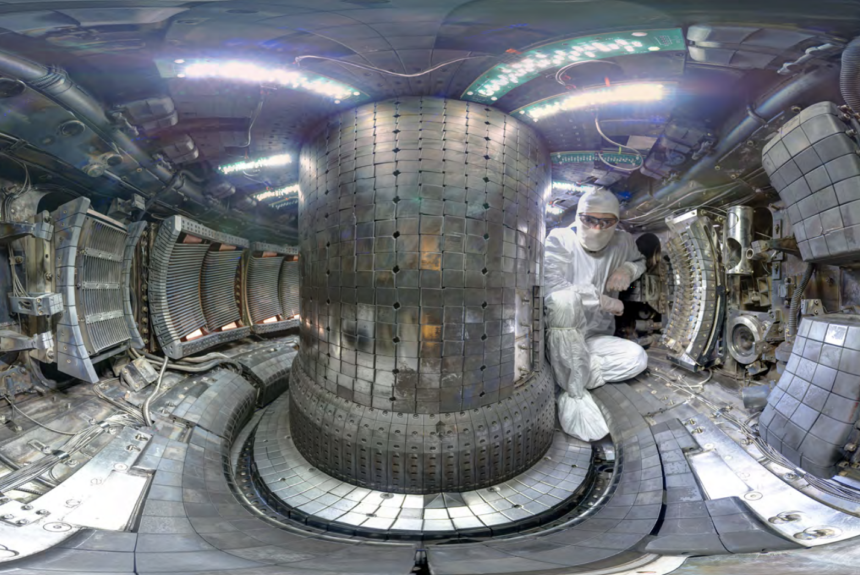Imagine a world full of clean, abundant, cheap energy. As the world ramps up its efforts to tackle climate change and move away from fossil fuels, technologies like wind and solar power dominate the headlines. Yet, while these renewable sources of energy are undoubtedly crucial to a clean future, more exciting technology is now on the horizon.
British scientist and journalist Lord Matt Ridley believes that nuclear fusion plants could be less than 15 years away from contributing to electricity grids worldwide. While traditional nuclear plants, known as fission reactors, already contribute 55% of all carbon-free electricity in the U.S., nuclear’s share of American energy production has been steadily declining for a few decades now. The advent of fusion technology could provide the antidote to that unfortunate decline.
More than 20 privately-funded ventures worldwide, from the U.S. to Europe and China to Australia, are heavily investing to that end, trying to bring commercial fusion reactors to market. Billionaires like Jeff Bezos and Bill Gates have contributed nearly $2 billion to these projects. Most of these companies confidently state they expect to feed electricity into the grid by the end of the decade.
Meanwhile, the federal government has been spending around $600 million a year on fusion R&D, and the Energy Act of 2020 included an amendment to spur further investment in fusion research.
As I wrote for Human Progress last year, scientists are convinced that the race to nuclear fusion is closer than ever this time. A series of seven research papers was published around that time by MIT scientists who claimed to have proven the operability of a compact nuclear fusion reactor. For the longest time, the physical requirements of fusion weren’t showing much promise: the reactions consumed more energy than they produced. Yet, the MIT researchers argue that their model shows that the fundamental physics of nuclear fusion are, in fact, viable. If these findings pan out, we can expect a very bright, low-carbon future.
The start-up founded by these MIT scientists, called Commonwealth Fusion Systems, is currently testing an enormous magnet capable of generating immense heat that can be turned into electricity, approximating how a fusion reactor would eventually work. Meanwhile, scientists at Lawrence Livermore National Laboratory have managed to focus a laser light “onto a target the size of a BB, which resulted in a hot-spot the diameter of a human hair, generating more than ten quadrillion watts of fusion power for 100 trillionths of a second,” a written statement says. Chief Scientist Omar A. Hurricane called it a “Wright Brothers moment” in the race to commercial nuclear fusion.
Where regular fission plants (the ones we have today) split uranium atoms to release energy, fusion reactors imitate the sun’s method of energy production by colliding hydrogen atoms together. This “fusing” together of atomic nuclei releases four times more energy than a fission reaction, with far less radioactive fallout and waste.
These combinations of less waste and more energy make nuclear fusion preferable to nuclear fission. Indeed, while enjoying the same carbon-free benefits of traditional nuclear power, the fuel used for fusion energy reactions—hydrogen isotopes—is much more abundantly available than the uranium required for fission plants. Moreover, fusion produces far less radioactive waste, and this waste is also less dangerous.
However, getting there has its challenges. While the funding needs are being met by private and public investment, the government’s traditional approach to nuclear energy has been immensely counterproductive. An over-zealous regulatory regime has bogged nuclear plants down in miles of red tape, stifled innovation, and pushed up operating costs for the nuclear sector. Studies show that new regulations introduced in the 70s increased the quantity of piping per megawatt by 50 percent, steel by 41 percent, electrical cable by 36 percent, and concrete by 27 percent.
If we expect nuclear fusion ever to become commercially viable, federal authorities must reconsider the regulatory approach to nuclear energy. Regulators can take two main steps toward this end.:
First, the Nuclear Regulatory Commission must change its current prescriptive regulatory approach to one based on standards. Under the current prescriptive regulatory regime, the agency sets specific safety features and designs that each nuclear plant must follow to the letter, rather than setting safety standards that allow companies to experiment with the best plant design to meet those standards. Reforming that licensing process to be standards-based rather than prescriptive is vital. Innovation flows from experimentation, trial-and-error, and creativity, not government prescriptions. Encouraging companies to innovate with various fusion reactor designs to meet safety standards will place upward pressure on innovation and downward pressure on both time and cost.
Second, as has been emphasized by the Director of the Fusion Industry Association, nuclear fusion and fission are different technologies and should be entirely separated in the regulatory process. Fusion reactors have different safety profiles from fission reactors. As such, standards and protocols will differ between the two technologies. A new, specialized regulatory framework for nuclear fusion reactors must avoid lumping this next-generation technology with older, less-advanced plant designs. Such a framework should reflect nuclear fusion’s significantly lower risk profile.
Ultimately, the future of nuclear fusion is bright, but only if we support the industry adequately. A clean, nuclear-powered future is entirely possible if we actively invest in R&D, remove burdensome red tape, and learn from past mistakes.
Christopher Barnard is the National Policy Director at the American Conservation Coalition (ACC).
The views and opinions expressed are those of the author’s and do not necessarily reflect the official policy or position of C3.
